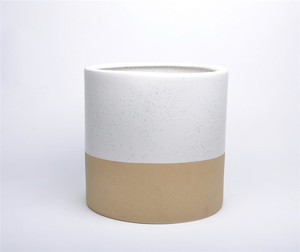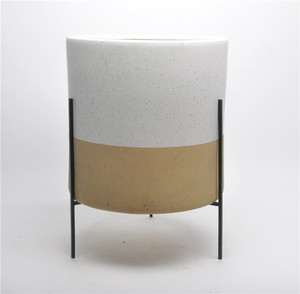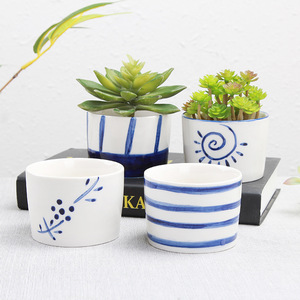(9959 products available)






























































































































































































A Chinese planter is a type of flower pot, often made of ceramic or clay, originating from China. Chinese planters come in a variety of styles and designs. They can be used indoors or outdoors to grow plants or flowers. There are different styles of Chinese planters. They include:
Traditional Chinese planters
The traditional Chinese planters are ancient. They have beautiful designs and show China's traditional art. They are often made of durable materials like stoneware or porcelain. They usually have detailed carvings or paintings on them. These might include Chinese flowers, birds, and other traditional patterns. The traditional planters are great for decorating inside homes. They show a connection to traditional Chinese culture and style.
Modern Chinese planters
Modern Chinese planters combine modern designs with useful features. They look sleek and stylish. They fit well with modern furniture and home decorations. They might have simple lines and minimalistic designs. They are often made of materials like fiberglass, ceramic, or metal. They are lightweight and weather-resistant. These planters are perfect for both indoor and outdoor use. They are ideal for those who want a modern look for their plants.
Chinese wooden planters
Chinese wooden planters are traditional Chinese planters made from wood. These planters have a classic and timeless design. They add warmth and richness to any space. The wooden planters are often adorned with intricate carvings. They may also have metal accents. They can be used indoors or outdoors. They are suitable for various plants.
Chinese lacquered planters
Chinese lacquered planters are made using the traditional Chinese lacquerware technique. They are often made from metal or wood and coated with lacquer. This gives them a glossy and smooth finish. Chinese lacquered planters come in many colors. They often feature detailed designs. These include floral patterns and scenes from nature. They are durable and stylish. They are ideal for displaying plants in homes and gardens.
Chinese zen garden planters
Chinese zen garden planters are small planters. They are designed for use in zen gardens or miniature rock gardens. They are often rectangular or square. They have clean lines and simple designs. These planters usually hold small plants or succulents. They focus on creating a calm and peaceful atmosphere. They are perfect for people who want to add a zen touch to their indoor or outdoor spaces.
Various artistic traditions and cultural influences have shaped the different designs of Chinese planters throughout history, making them a fascinating blend of beauty and practicality. Chinese planters come in various styles, each reflecting China's rich cultural heritage and artistic traditions. These styles include:
Traditional porcelain planters
Chinese porcelain planters have been made since the Ming dynasty (13681644). They use fine white clay and a special glaze that makes them shiny and smooth. The potters paint bright pictures on the pots using blue and other colors before baking them in a hot oven. This baking makes the pictures last a long time. These pots are very pretty and have a long history.
Terracotta planters
Terracotta Chinese planters are made from natural red clay. The clay is not mixed or changed, so the pots keep a rough, earthy look. The potters shape the clay by hand or with a spinning wheel and then bake the pots in a hot oven. These pots are strong and good for plants because they let air and water move through them easily. They have a simple, old-fashioned style that many people still like today.
Yixing clay (purple sand) planters
Yixing clay is a special type of clay used to make Chinese teapots and planters. Yixing clay comes from a small town in China. The clay can be molded into very thin shapes. Pots made from Yixing clay keep their designs for a long time. These pots are also very good for plants because the clay material is porous and allows for good air exchange. Yixing clay has a unique reddish-purple color that comes from iron content. This clay is also known for its smooth texture and ability to retain moisture while providing good drainage, making it ideal for delicate roots. Yixing clay planters often have intricate carvings or reliefs that tell stories or show nature scenes. They are considered high-quality and are more expensive than other types of pots.
Painted and lacquered wood planters
Wooden Chinese planters are made from different types of wood, such as pine, cedar, or bamboo. The wood is shaped and carved into beautiful designs. Then the planters are painted with bright colors or coated with lacquer, which makes them shiny and protects them. These wooden planters often have pictures or carvings of Chinese flowers, birds, and other scenes from nature. Using wood makes these planters strong and long-lasting. The wood gives them a warm, natural look that fits well in any garden or home. The lacquer makes the planters waterproof, so they can be used indoors and outdoors without getting damaged.
Chinese planters are very versatile. They can be used in many different ways. They add beauty and function to any space. Here are some common scenarios:
Style and Design:
Chinese planters come in various styles, from traditional Ming and Qing dynasty designs to more modern interpretations. Consider the style of your garden or indoor space and choose a planter that complements it.
Materials:
Chinese planters are made from different materials, such as ceramic, porcelain, wood, and stone. Ceramic and porcelain planters are great for showcasing intricate hand-painted designs. Wooden planters offer a rustic look and are usually more durable. Stone planters are heavy but can withstand various weather conditions.
Size and Proportion:
Chinese planters should be proportional to the plants they will hold. The planter should be large enough for the plant's root system to grow but not too big, as this can make the plant look dwarfed. Consider the size of the area where the planter will be placed to ensure it fits well.
Drainage:
Good drainage is crucial for plant health. Ensure the Chinese planter has a drainage hole at the bottom to prevent waterlogging. If the planter doesn't have a drainage hole, consider adding gravel at the bottom to improve drainage.
Craftsmanship:
When choosing a Chinese planter, look for one with excellent craftsmanship. In traditional ceramics, this means looking for a planter with even glaze application, well-defined hand-painted designs, and no cracks or chips. In wooden planters, good craftsmanship means solid construction and quality wood. In stone planters, look for smooth surfaces and well-defined edges.
Authenticity:
If one wants an authentic Chinese planter from a specific historical period, researching the characteristics of planters from that period is essential. One can ask the seller about the planter's history to ensure it truly comes from the era they want.
Usage:
Consider whether the Chinese planter will be used indoors or outdoors. Indoor planters may need to be lighter and more decorative, while outdoor planters should be sturdier and able to withstand the elements.
Q1: What are the benefits of using a Chinese planter?
A1: Chinese planters add culture, grace, and sophistication to gardening or interior decoration. They are timeless pieces that can make any setting more elegant.
Q2: Can Chinese planters be used outdoors?
A2: Yes, many Chinese planters are suitable for outdoor use. They can withstand various weather conditions, including rain and sunlight.
Q3: How can one care for a Chinese planter?
A3: Cares involve regular cleaning, avoiding harsh chemicals, and protecting the planter from extreme temperature changes.
Q4: What styles of Chinese planters are available?
A4: There is a wide range of styles, including traditional, modern, rustic, and minimalist, which can suit different tastes and settings.
Q5: What materials are used in making Chinese planters?
A5: They are made from various materials, such as ceramics, porcelain, stone, wood, and brass.